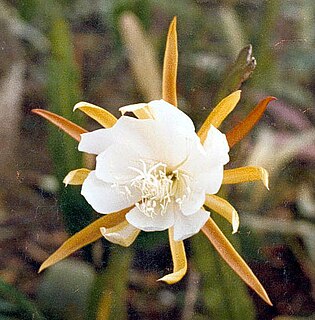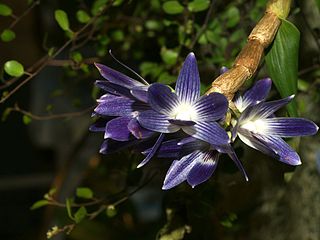
Dendrochilum is a genus of epiphytic, lithophytic and a few terrestrial flowering plants in the orchid family (Orchidaceae). The name of this genus is derived from Ancient Greek words dendron ("tree"), and either cheilos ("lip") or chilos, alluding to either the flowers' large lip or to their epiphytic growth. These orchids are popular among fans of non-traditional orchid curiosities.

Epiphyllum laui is a cactus species native to Mexico and grown as an ornamental.

Dendrobium kingianum, commonly known as the pink rock orchid, is a flowering plant in the orchid family Orchidaceae and is endemic to eastern Australia. It usually grows on rocks, rarely as an epiphyte, and has thin, spreading leaves and spikes of up to fifteen, usually pink flowers in late winter to spring. It is popular in Australian native horticulture and is a commonly cultivated orchid among Australian orchid species growers.

Dendrobium tetragonum, commonly known as the tree spider orchid, is a variable species of epiphytic or lithophytic orchid endemic to eastern Australia. Tree spider orchids are unusual in having pendulous pseudobulbs that are thin and wiry near the base then expand into a fleshy, four-sided upper section before tapering at the tip. There are only a few thin but leathery leaves at the end of the pseudobulbs and up to five flowers on relatively short flowering stems. To allow for the variations in the species there are five subspecies and a variety, some with a unique common name.

Dendrobium linguiforme, commonly known as the thumbnail orchid, tick orchid or tongue orchid, is a plant in the orchid family Orchidaceae and is endemic to eastern Australia. It grows on trees or on rocks, with wiry, prostrate stems, prostrate, fleshy leaves and spikes of up to twenty white to cream-coloured flowers in early spring.

Dendrobium moorei, commonly known as the drooping cane orchid, is a species of epiphytic or lithophytic orchid in the family Orchidaceae and is endemic to Lord Howe Island. It has cylindrical pseudobulbs, leathery, dark green leaves and between two and fifteen small, white drooping flowers that do not open widely.
Dendrobium nativitatis, commonly known as the Christmas Island crimp orchid, is a species of epiphytic orchid that is endemic to Christmas Island, an Australian territory in the north-eastern Indian Ocean. It has long, straggly stems, flattened pseudobulbs, a single leathery leaf and a single pale yellow flower.

Dendrobium milaniae is flower of the Orchid family found in Leyte, Visayas in the Philippines, where it is found growing as an epiphyte above bodies of water at elevations up to 600 metres. The flower grows to approximately 1.5 centimetres (0.59 in). The plant is semi-pendulous and sympodial. Pseudobulbs are 10 cm by 2 cm; 3 to 6 green lanceolate leaves are present on the top third of the pseudobulb. Hans Fessel and Emil Lückel named this species in 1996 in Die Orchidee.

Acanthophippium mantinianum or Mantin's acanthophippium, is a species of the family Orchidaceae. It is currently the only endemic Acanthophippium species known in the Philippines and one of the two species alongside with Acanthophippium pictum. It was named in honor of M. Georges Mantin, an orchid horticulturalist and hybridizer from Olivet, France. It is an erect and sympodial species with 15 cm long tapering pseudobulbs and large, thin leaves, which can be up to 60 cm long and 15 cm wide. The plant is endemic to the islands of Luzon, Leyte, Mindoro, Negros and Panay in the Philippines where it is found at elevations from 500 to 1500 meters.

Dendrobium victoriae-reginae is a member of the family Orchidaceae endemic to the Philippines.

Dendrobium guerreroi, or Guerrero's dendrobium, is a member of the family Orchidaceae endemic to the Philippines. It was named in honor of Mr. Guerrero, a Filipino orchid collector in the 1900s. This species is a small to medium to large sized, warm growing epiphyte with thin descendant, clumping pseudobulbs that rarely branch and carry many, unsubdivided, pointed fleshy leaves. Flowers are 3 centimeters and are yellow with light orange labia.
Cylindrolobus cootesii is plant species of the family Orchidaceae endemic to the Philippines. It is found in the Philippines on the island of Luzon at elevations around 500 meters. It is a small to medium-sized, hot growing epiphyte with an elongated, slightly compressed stem carrying many towards the apical 1/2 to 1/3, distichous, spreading, narrow lanceolate, leathery, basally clasping leaves. It bears flowers on an axillary, .6 to .8" long, single flowered inflorescence. Cylindrolobus cootesii is named after Jim Cootes, an Australian orchid collector.

Phalaenopsis × intermedia, the intermediate phalaenopsis, is a natural occurring hybrid of epiphytic orchid endemic and most commonly seen orchid species in the Philippines. A progeny of Phalaenopsis aphrodite and P. equestris, this orchid thrives in the heat of the lowlands, in primary and secondary forests at an altitude of sea level to 300 meters where it blooms all year round. Unlike other natural hybrid within the genus, P. × intermedia seldom found growing within the range of its parent species and has formed sexually reproducing, stable populations in the wild. All red-lipped Phalaenopsis have pedigrees that can be traced back to this orchid.
Cyrtostylis oblonga, commonly known as the winter orchid or gnat orchid, is a species of orchid endemic to New Zealand. It has a single rounded leaf and a flowering stem with up to four pink or pinkish green flowers with a flat, oblong labellum.
Dendrobium lichenastrum, commonly known as the common button orchid, is a species of epiphytic or lithophytic orchid endemic to far north Queensland. It has a creeping, branching rhizome surrounded by papery bracts, small egg-shaped to round, fleshy, dark green leaves and a single white, cream-coloured or pink flower with red stripes and an orange labellum.

Dendrobium toressae, commonly known as the sparkle orchid or mica orchid, is a species of epiphytic or lithophytic orchid with highly branched stems forming dense patches. The leaves are crowded, fleshy and dark green with a glittery surface. A single cream-coloured to pale pink flower with a yellow labellum develops in a leaf axil. It is endemic to tropical North Queensland.
Dendrobium eungellensis, is an epiphytic orchid in the family Orchidaceae and is endemic to northern Queensland. It has dark greenish brown pseudobulbs with up to three leaves on the end and up to eight fragrant white flowers with thin, spreading sepals and petals. It grows in open forest in the Eungella National Park.
Dendrobium clementsii, commonly known as the Cape York crimp orchid, is a species of epiphytic or lithophytic orchid that is endemic to tropical North Queensland, Australia. It has long stems, tapering pseudobulbs each with a thin, leathery dark green leaf and clusters of short-lived, cream-coloured flowers with a purple labellum.

Vanda roeblingiana, Roebelen's vanda, is a species of orchid endemic to the mountain provinces of the island of Luzon in the Philippines. Hugh Low, a British colonial administrator and naturalist introduced the plant to London in 1893. The next year, Robert Allen Rolfe, an English botanist formally described the plant and thought it was originally collected from the vicinity of Singapore or Peninsular Malaysia. Low, who works in Clapton Nursery had collecting expedition to Southeast Asia with Singapore as headquarter.
Pseuderia samarana is an endemic species of plant in the family Orchidaceae found in Samar Island and is the first generic record for the genus Pseuderia in the Philippines. The species is initially terrestrial during its seedling stage, then becomes epiphytic upon reaching maturity. It shared similarities with P. floribunda, and P. frutex. However, the species scented, 2-flowered inflorescence significantly differs from the latter, along with its narrower labellum and the characteristically entire clinandrium margins. The species is considered Critically Endangered, and is found only in top portion of forest over limestone, and is threatened by land use conversion, timber poaching, and slash-and-burn farming.













